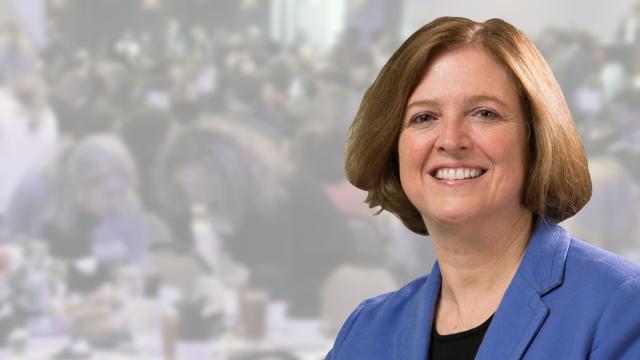
M. Katherine Banks, Texas A&M University vice chancellor of engineering and national laboratories, is the 2019 winner of the Pinnacle Award, presented at Hart Energy’s Oil and Gas Investor’s 25 Influential Women in Energy Luncheon on Feb. 12.
HOUSTON—If the United States wants to remain competitive on a global scale, the nation must increase the number of graduates being prepared for STEM fields, said M. Katherine Banks, Texas A&M University vice chancellor of engineering and national laboratories.
It’s imperative that the number of women going into STEM (science, technology and mathematics) increase, said Banks, who received the Pinnacle Award during Hart Energy’s Oil and Gas Investor’s 25 Influential Women in Energy Luncheon on Feb. 12. She told the audience of nearly 1,100 energy professionals that STEM fields need the creativity and diversity of perspectives for better product design and development.
“Studies reveal that men and women approach product design differently,” said Banks, who also serves as the dean of Texas A&M’s college of engineering. “If products are developed without the perspective of half of the consumer base, problems can arise.”
Banks cited issues involving first-generation air bags for cars, which were designed and implemented by a group of male engineers. The design was for male bodies, which resulted in production malfunction for both women and children. Also, early voice recognition systems were calibrated to only male voices, which resulted in poor results for women.
Banks, whose own college of engineering has a goal of increasing its percentage of women from 24% to 32% as part of overall enrollment growth by 2025, said radical steps must be taken to identify, attract and nurture prospective women who may go into STEM and energy fields.
According to a Forbes Magazine report in 2016, the share of women in the oil and gas work force was below 20%, while women in senior level positions hovered between 10% and 15%.
“We must provide young girls with hands-on, learn-through-doing opportunities and encourage each and every one of them to consider an engineering career,” Banks said. “We need to tell them not only what we do but why we do it.
“There is a wide range of opportunities for women in energy and other STEM fields and this must be communicated to girl students at all levels. It is time to thoughtfully embrace those who will follow in our footsteps and prepare the path for the female leaders of the future.”
A pioneer herself, when Banks took over as dean of the college of engineering in 2011 she became the first woman to head Texas A&M’s largest college. She leads one of the largest engineering schools in the country with more than 16,900 students and 500 faculty. Banks initiated the 25 by 25 program, which is a controlled enrollment program that has a goal of 25,000 engineering students by 2025.
As vice chancellor, she oversees coordination and collaboration among the engineering, academic and research programs at seven universities throughout the A&M System, as well as three state agencies: the Texas A&M Engineering Experiment Station (TEES), the Texas A&M Engineering Extension Service (TEEX) and the Texas A&M Transportation Institute (TTI). Banks also is TEES director, overseeing research administration of more than 4,800 projects and $208 million in sponsored research awards.
As Banks looks at ways to grow her engineering program, she said she also feels a responsibility to increase the number of women in the field. Currently there are 1.5 million engineers working in the U.S. and only 14% are women.
She pointed out that women make up in excess of 45% of the student population in other critical professionals such as medicine and law while women receiving engineering degrees remain less than 20% nationally.
“This new approach to education will produce technology leaders who are uniquely prepared to address tomorrow’s challenges, however, to meet the need for expanded engineering work force it is essential that we increase our recruitment of women,” Banks said. “I recognize that I’m preaching to the choir here, but the need to increase opportunities for women and to pursue degrees in STEM fields and energy is crucially important.
“Public awareness of the need for more women for STEM has never been higher. But the issue is more than just about disparity of numbers. The low number of women in STEM fields means we are lacking the perspective of half the population when creating high-tech economic development opportunities. Engineering relies on design creativity and diversity of perspective and that leads to better product design and development.”
Contact Terrance Harris at tharris@hartenergy.com.
Recommended Reading
Some Payne, But Mostly Gain for H&P in Q4 2023
2024-01-31 - Helmerich & Payne’s revenue grew internationally and in North America but declined in the Gulf of Mexico compared to the previous quarter.
Kimmeridge Fast Forwards on SilverBow with Takeover Bid
2024-03-13 - Investment firm Kimmeridge Energy Management, which first asked for additional SilverBow Resources board seats, has followed up with a buyout offer. A deal would make a nearly 1 Bcfe/d Eagle Ford pureplay.
M4E Lithium Closes Funding for Brazilian Lithium Exploration
2024-03-15 - M4E’s financing package includes an equity investment, a royalty purchase and an option for a strategic offtake agreement.
Laredo Oil Subsidiary, Erehwon Enter Into Drilling Agreement with Texakoma
2024-03-14 - The agreement with Lustre Oil and Erehwon Oil & Gas would allow Texakoma to participate in the development of 7,375 net acres of mineral rights in Valley County, Montana.
California Resources Corp. Nominates Christian Kendall to Board of Directors
2024-03-21 - California Resources Corp. has nominated Christian Kendall, former president and CEO of Denbury, to serve on its board.





